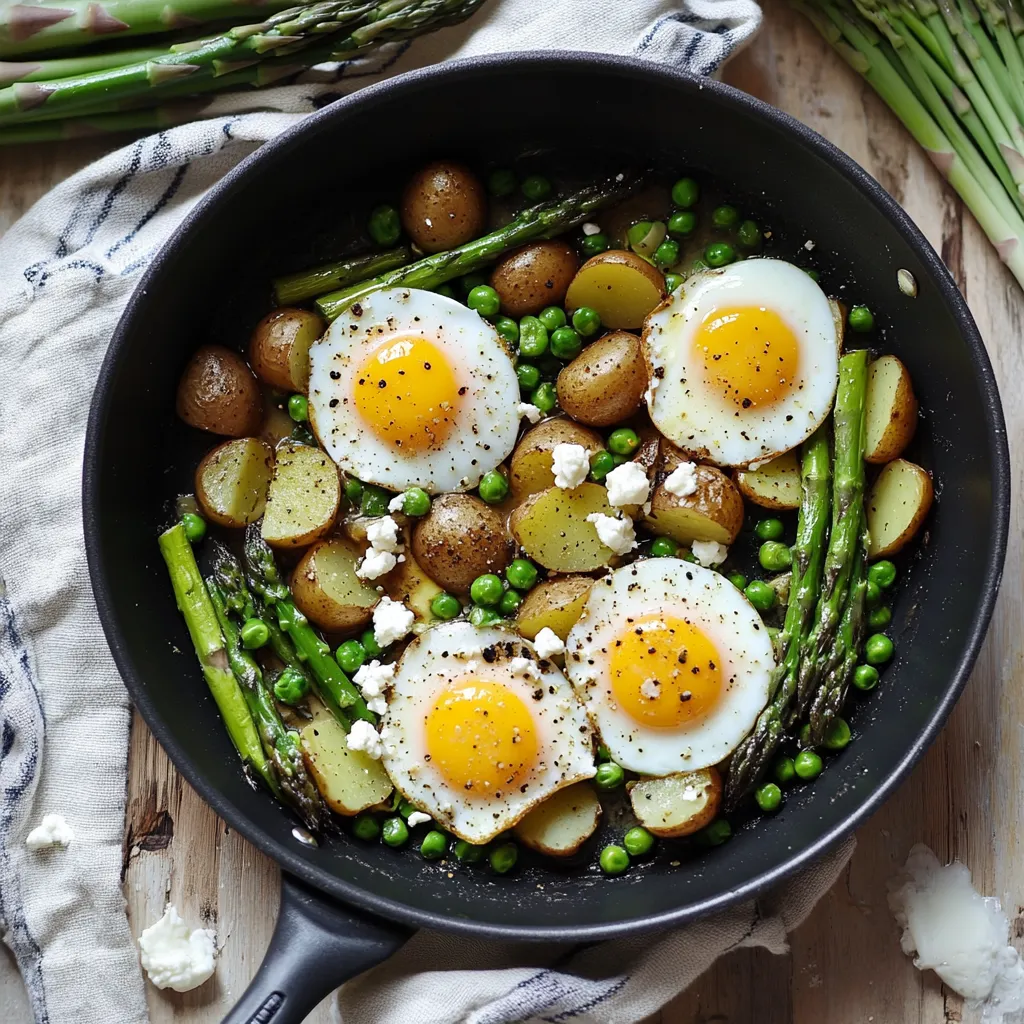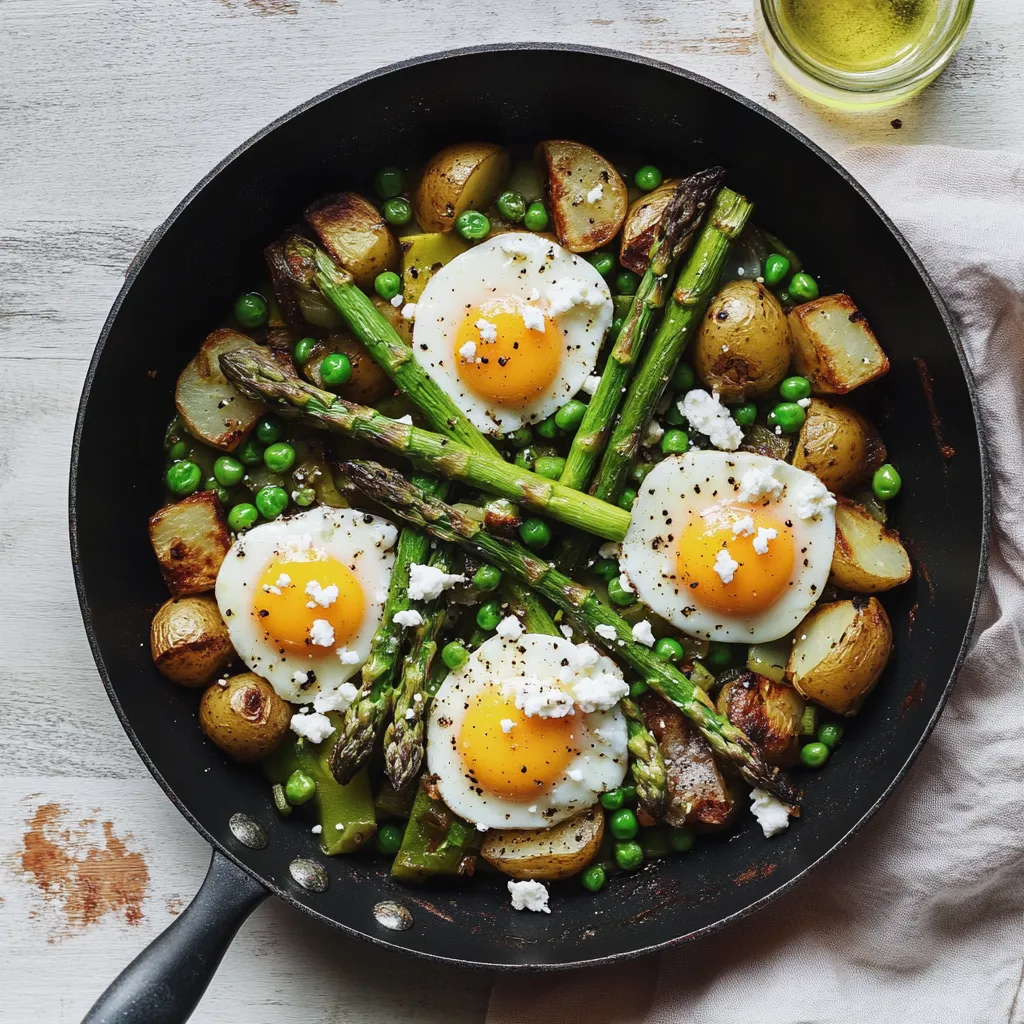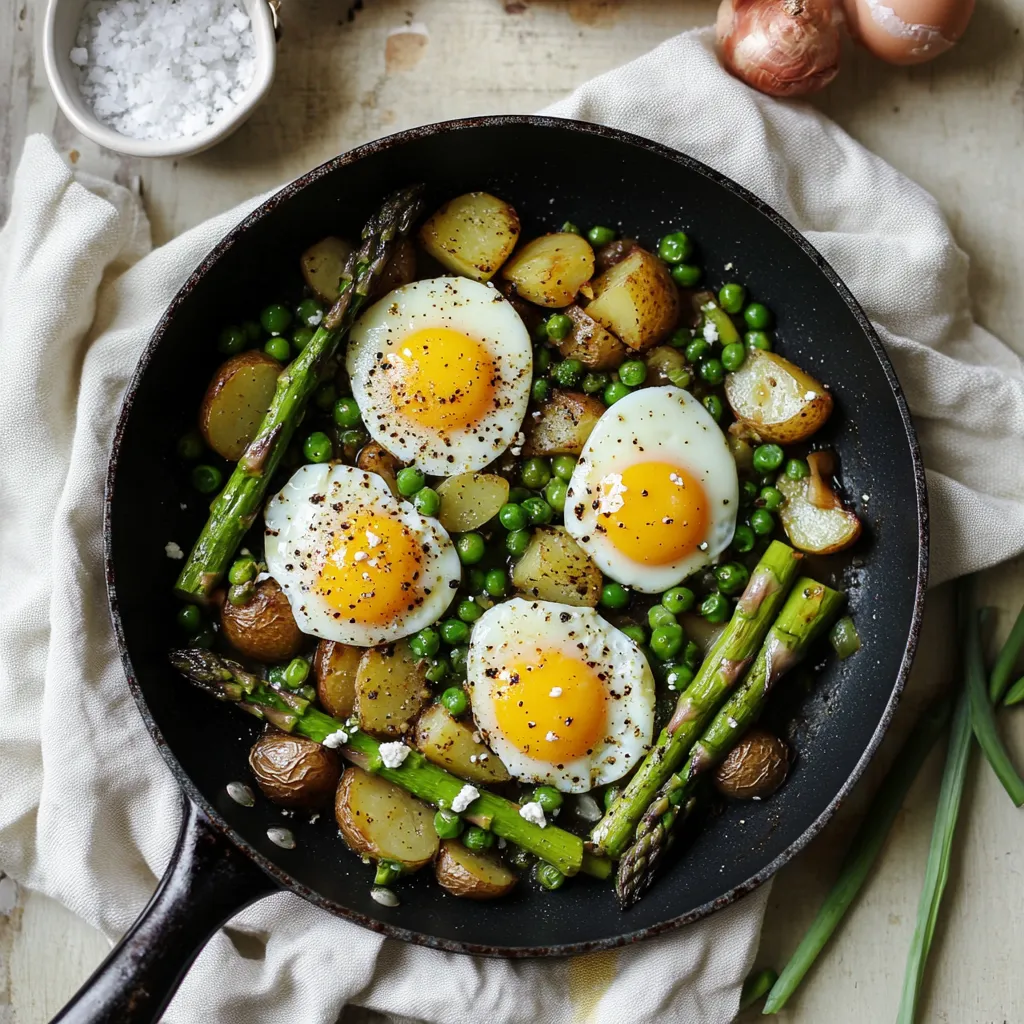 Pin it
Pin it
This vibrant asparagus and eggs breakfast skillet has transformed my weekend brunch routine with its perfect balance of seasonal vegetables and protein. The combination of tender asparagus, creamy potatoes, sweet leeks, and perfectly cooked eggs creates a nutritional powerhouse that's as beautiful as it is delicious.
I discovered this recipe during spring asparagus season last year, and it's now requested by my family whenever the first tender spears appear at our farmers market. The bright colors and flavors make even ordinary weekday breakfasts feel special.
Ingredients
- Olive oil: Provides the perfect base for sautéing and adds a subtle Mediterranean flavor
- Garlic cloves: Bring essential aromatic depth to the dish
- Leek: Offers a milder onion flavor that pairs beautifully with eggs
- Green onion: Adds a fresh pop of color and sharpness
- Small potatoes: Create a hearty base and wonderful texture contrast
- Asparagus spears: Bring seasonal freshness and visual appeal
- Green peas: Add sweetness and bright color throughout the skillet
- Large eggs: Provide rich protein that becomes perfectly set with runny yolks
- Feta cheese: Delivers a salty tangy finish that brings everything together
- Salt and pepper: For seasoning each layer of flavor
Step-by-Step Instructions
- Prep and Chop:
- Thoroughly wash and prepare all vegetables before beginning. Remove woody asparagus ends and cut spears into thirds. Quarter small potatoes while keeping their nutritious skins intact. Slice leeks into even rounds approximately 1/4 inch thick, discarding the tough bottom portion. Mince garlic cloves finely for even distribution of flavor.
- Build the Aromatic Base:
- Heat olive oil in a large skillet over medium high heat until shimmering but not smoking. Add minced garlic, sliced leeks, and diced green onion, stirring constantly for about two minutes. Watch carefully to prevent garlic from burning while allowing the aromatics to become fragrant and slightly softened.
- Cook the Potatoes:
- Add quartered potatoes to the aromatic mixture, stirring frequently to coat them evenly with oil and flavors. Continue cooking for approximately 10 minutes until potatoes begin to soften and develop golden edges. The potatoes need more time than other vegetables so this step ensures everything finishes cooking simultaneously.
- Introduce Spring Vegetables:
- Add prepared asparagus spears and green peas to the skillet, seasoning generously with salt and pepper. Stir frequently for about 5 minutes until asparagus brightens in color and begins to tenderize while maintaining a slight crispness. The peas will warm through quickly whether fresh or frozen.
- Create Egg Wells:
- Using your spatula, carefully push vegetables aside to create four distinct wells or indentations in the mixture. These spaces will cradle your eggs and help them cook evenly while nestled among the vegetables. Make sure the wells reach down to the pan surface.
- Add Eggs and Cheese:
- Carefully crack one egg into each prepared well, keeping yolks intact. Sprinkle crumbled feta cheese evenly across the entire surface of the skillet, allowing some to fall onto the eggs and some to integrate with the vegetables for varied texture and flavor distribution.
- Cover and Finish:
- Place a lid over the skillet and reduce heat slightly. Allow eggs to cook undisturbed for 5 to 7 minutes until whites are completely set but yolks remain slightly runny. The trapped steam will help cook the egg tops without requiring flipping. Remove from heat immediately to prevent overcooking.
 Pin it
Pin it
Asparagus is truly the star ingredient here and I wait all year for its brief season. My grandmother taught me that the best asparagus has tight closed tips and stalks that snap cleanly when bent. This breakfast brings back memories of spring mornings in her kitchen where she'd serve something similar using vegetables freshly picked from her garden.
Storage Solutions
Leftover skillet breakfast keeps remarkably well for a dish containing eggs. Store any portions in an airtight container in the refrigerator for up to three days. The eggs will solidify more during storage but the flavor remains delicious. For reheating, microwave portions gently at medium power to prevent the eggs from becoming rubbery. The dish won't retain quite the same texture after storage but makes for a quick and satisfying meal later.
Smart Substitutions
This forgiving recipe welcomes adaptations based on what's available in your kitchen. Spinach can replace asparagus during off seasons, while fingerling or red potatoes work beautifully in place of creamer potatoes. The cheese element offers tremendous flexibility. Try soft goat cheese for tangy creaminess, shaved parmesan for savory depth, or even a dairy free alternative if needed. The recipe's foundation remains solid even with significant ingredient swaps.
Serving Suggestions
Transform this versatile skillet from casual breakfast to elegant brunch by adding complementary sides. Serve with toasted sourdough bread for soaking up the rich egg yolks, or alongside a simple green salad dressed with lemon vinaigrette for a more substantial meal. For entertaining, present the entire skillet at the table with fresh herbs scattered on top and a pitcher of mimosas nearby. The vibrant colors make an impressive centerpiece for any gathering.
 Pin it
Pin it
Frequently Asked Questions
- → What potatoes work best for this dish?
Mini or baby potatoes like creamer, fingerling, or peewee varieties work best for their tender texture and quick cooking time. Leave skin on for added nutrition.
- → Can I substitute the asparagus?
Yes, you can use other vegetables like green beans, zucchini, or broccoli florets as an alternative to asparagus. Adjust cook times as needed.
- → How can I make this meal dairy-free?
Simply omit the feta cheese or use a dairy-free alternative. The dish will still be flavorful thanks to the seasoned vegetables and eggs.
- → Can I omit green peas?
Yes, green peas can be omitted if you prefer or replaced with another vegetable like diced bell peppers or mushrooms.
- → How do I store leftovers?
Store leftovers in an airtight container in the fridge for up to 3 days. Reheat gently in the microwave or a skillet for best results.
- → Can I use frozen vegetables?
Yes, you can use frozen asparagus or peas. There's no need to thaw the peas beforehand; simply add them to the skillet and cook as directed.
- → What can I serve with this dish?
Serve this skillet with crusty bread, a fresh green salad, or fruit for a complete and satisfying meal.
